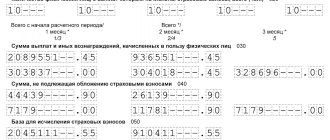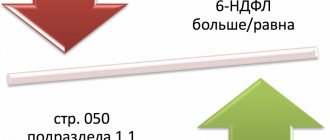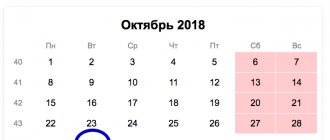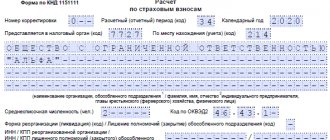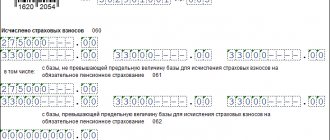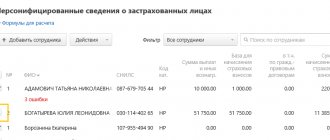Entrepreneurs and companies using hired labor are required to regularly make payments on insurance contributions and submit the “Calculation of Insurance Contributions” to the tax authority. An example of filling out a reporting form contains data on payments to the workforce, taking into account the period of income accrual and the type of insurance system. A separate information block of the calculation is dedicated to the personal data of employees, which are necessary to create a personalized accounting database for all insured persons.
ERSV deadline for 2021 and current form
Absolutely all employers are required to submit insurance premium calculations (ERSV):
- Companies, their branches and separate divisions (if these separate divisions independently calculate and pay contributions) “surrender” to the Federal Tax Service at the place of registration or business (clause 7 of Article 431 of the Tax Code of the Russian Federation).
- Individual entrepreneurs - to the inspectorate at the place of registration (registration).
If there were no accruals in the reporting period (from January to December 2021), you are required to submit a zero calculation by filling out the required sections and applications. This will allow tax authorities to distinguish those organizations that did not have accruals from those that forgot to submit calculations (for entrepreneurs, such an obligation is not established by law).
The deadline for submitting the DAM is set by the Tax Code of the Russian Federation on the 30th day of the month following the reporting quarter. The results of 2021 must be reported no later than January 30, 2021.
If the DAM for 2021 is submitted 10 days later than the deadline, tax authorities have the right to block the current account (clause 3.2 of Article 76 of the Tax Code of the Russian Federation). The same trouble threatens the policyholder who submitted the calculation on time, but with erroneous information: the tax authorities will not accept the report, and it will be considered not submitted.
The RSV form has not changed. The calculation for the 4th quarter of 2021 is still submitted in the form approved. By order of the Federal Tax Service of October 10, 2016 N ММВ-7/11/551.
The report for the 4th quarter of 2021 can be submitted on paper by policyholders whose payroll for 2021 does not exceed 24 employees inclusive. All employers with a large payroll are required to report electronically via telecommunications channels. For violation of this requirement, the policyholder will face a fine for the incorrect method of submitting the calculation - 200 rubles. (Article 119.1 of the Tax Code of the Russian Federation).
Program for generating calculations for insurance premiums
There are many computer systems that allow you to generate calculations for insurance premiums 2021 (you can use the link above) automatically. The 1C program is rightfully considered the most popular, which includes many reports regulated by law, among which there is also a calculation of insurance premiums (form KND 1151111). However, it is not economically feasible for every employer to purchase an expensive license to use the software. At the same time, various Internet resources come to the rescue, providing the opportunity to generate calculations for insurance premiums 2021 (KND form 1151111) online.
Some of the online accounting services include Kontur and My Business.
You can download the insurance premium calculation form from the link provided above.
Registration of ERSV for 2021
The report consists of 3 sections and 24 sheets, which display information about all insurance premiums, except for “accidental” ones. But you only need to fill out those that are mandatory and for which you have indicators.
Let's consider who should fill out which sheets when preparing reports for the 4th quarter of 2021.
| Sheet | Is it necessary to fill out | Who fills it out |
| Title | Yes | All policyholders |
| Sheet “Information about an individual who is not an individual entrepreneur” | No | Only individuals who are not registered as entrepreneurs |
| Section 1 | Yes | All |
| Annex 1 | Yes | Subsections 1.1 and 1.2 - filled out by all policyholders, Subsections 1.3, 1.3.1., 1.3.2, 1.4 are completed only if there are payments of contributions for additional tariffs |
| Appendix 2 | Yes | All employers indicate information about insurance premiums in case of temporary disability and maternity |
| Annexes 3 and 4 | No | Fill out only those employers who paid sick leave benefits in the reporting period |
| Appendix 5 | No | Filled out by IT firms that have the right to apply reduced tariffs |
| Appendix 6 | No | They are drawn up by simplifiers who have the right to apply reduced tariffs in accordance with paragraphs. 5 p. 1 art. 427 Tax Code of the Russian Federation |
| Appendix 7 | No | NPOs engaged in activities named in paragraphs. 7 clause 1 art. 427 of the Tax Code of the Russian Federation, which allows you to pay contributions at reduced rates |
| Appendix 8 | No | Businessmen apply for a patent, with the exception of those who work in catering, retail or rent out real estate |
| Appendix 9 | No | Designed for those employers who pay income to foreigners and/or persons temporarily staying in the Russian Federation |
| Appendix 10 | No | Issued only in relation to payments to students working in student teams under a GPC or labor agreement |
| Section 2 and Appendix 1 | No | Only heads of peasant farms in relation to contributions for themselves and members of the farm |
| Section 3 | Yes | Employers record pers. information on all hired persons |
FILLING SEQUENCE
Start with the title page. Then form Section. 3 for each employee who was registered with you in the 4th quarter. After this, fill out the Appendices to Section. 1. And last but not least, Section itself. 1.
RSV filling mechanism
The DAM must be filled out in rubles and kopecks, and all indicators must be entered from left to right, starting from the very first cell. In calculations submitted electronically or when created through a computer program, dashes are not placed in empty cells (Order of the Federal Tax Service of the Russian Federation dated October 10, 2016 No. ММВ-7-11/551).
The field “Last name ________I.___O.___” is intended to be filled in by individuals who are not registered as individual entrepreneurs and have not indicated their TIN in the DAM. Organizations do not fill out this field.
Title page
The main fields of the title include “standard” information about the policyholder:
- Name.
- INN/KPP.
Separate divisions that independently pay income to employees indicate their checkpoint.
- Correction number (001, 002, etc.). For the initial calculation, enter 000 in this field.
- The reporting period code is 33 for a 9-month report.
- Federal Tax Service code where the calculation is submitted.
- In the “location” field, enter the code corresponding to where the payment is being submitted. Our table will help with this:
- OKVED code.
- Full name of the person signing the report and date of signing.
- Leave the field “to be filled in by a tax authority employee” blank.
Personalized information – section 3 of the ERSV for 2021
Complete section 3 separately for each employee. Please specify:
- in field 040 – a serial number that you define yourself. This can be either the number of personalized information in order (1, 2, 3, etc.) or the employee’s personnel number (Letter of the Federal Tax Service dated January 10, 2017 N BS-4-11/);
- in field 050 – the date of payment;
- in line 120 - for a Russian employee the code is “643”, for a foreigner - the code of his country from OKSM;
- in line 140 - code of the type of document identifying the employee. If it is a Russian passport, write “21”.
The category code of the insured person (column 200) for citizens of the Russian Federation is “NR”. Codes for foreigners: temporarily staying - VPNR, temporarily residing - VZHNR. If you pay contributions at reduced rates on the simplified tax system, the codes will be different: citizens of the Russian Federation - PNEED, temporarily staying foreigners - VPED, temporarily residing foreigners - VZhED.
In columns 210 - 250, show payments to the employee and accrued contributions to compulsory pension insurance from a base not exceeding the limit for the 4th quarter of 2018 - monthly and in total.
If payments were not accrued to the employee in the 4th quarter of 2021, then do not fill out subsection 3.2 (Letter of the Ministry of Finance dated September 21, 2017 No. 03-15-06/61030).
Example:
Payments to Potapov, a citizen of the Russian Federation, and contributions accrued from them to the compulsory pension insurance for the 4th quarter of 2021.
| Index | October | november | December | 4th quarter |
| All payments, rub. | 28 000 | 28 181,45 | 28 000 | 84 181,45 |
| Non-taxable payments, rub. | – | 4 602,90 | – | 4 602,90 |
| Contribution base, rub. | 28 000 | 23 578,55 | 28 000 | 79 578,55 |
| Contributions to community pension insurance, rub. | 6 160 | 5 187,28 | 6 160 | 17 507,28 |
A sample of section 3 as part of the DAM for the 4th quarter of 2021 will look like this:
Expenses for payment of benefits – Appendix 3 to Section 1
In Appendix 3, reflect only benefits from the Social Insurance Fund accrued in 2021. The date of payment of the benefit and the period for which it was accrued do not matter. For example, reflect a benefit accrued at the end of December and paid in January 2021 in the calculation for 2021. Reflect the sick leave benefit, which is open in December and closed in January, only in the calculation for the 1st quarter of 2021 (Letter Federal Tax Service dated June 14, 2018 N BS-4-11/11512).
Do not indicate benefits at the expense of the employer for the first three days of the employee’s illness in Appendix 3.
Enter all data on a cumulative basis from the beginning of 2021 to December 31 (clauses 12.2 – 12.4 of the Procedure for filling out the calculation).
In column 1, indicate on lines 010 – 031, 090 the number of cases for which benefits were accrued. For example, in line 010 - the number of sick days, and in line 030 - maternity leave. On lines 060 – 062, indicate the number of employees to whom benefits were accrued (clause 12.2 of the Procedure for filling out the calculation).
In column 2, reflect (clause 12.3 of the Procedure for filling out the calculation):
- in lines 010 – 031 and 070 – the number of days for which benefits were accrued at the expense of the Social Insurance Fund;
- in lines 060 – 062 – the number of monthly child care benefits. For example, if you paid benefits to two employees throughout the year, enter 24 in line 060;
- in lines 040, 050 and 090 - the number of benefits.
Example:
For 2021 the organization:
- paid for 3 sick days. At the expense of the Social Insurance Fund, 15 days were paid, the amount was 22,902.90 rubles;
- awarded one employee an allowance for caring for her first child for October, November, December, 7,179 rubles each. The amount of benefits for 3 months amounted to 21,537.00 rubles.
The total amount of benefits accrued is RUB 44,439.90. (RUB 22,902.90 + RUB 21,537.00).
Rules for filling out the insurance premium calculation form
In order to dispel doubts about how to fill out the form for calculating insurance premiums, you should refer to the order that approved the form for the unified calculation of insurance premiums (you can download it from the link given above).
The need to fill out certain sections is determined by the specifics of the organization’s activities. The following elements of the new form for calculating insurance premiums are identified, which are mandatory for completion by all policyholders without exception:
- 1st Section, affecting general information about contributions to be transferred;
- Section 1, Appendix 1, Subsection 1.1 – information on pension contributions;
- 1st Section, Appendix 2, Subsection 1.2 – data on health insurance;
- Section 1, Appendix 2 – information on social insurance contributions made;
- 3rd Section – personalized (personal) accounting information for each employee of the company.
Procedure for filling out calculations for insurance premiums 2018
Calculation of contributions for compulsory health insurance and compulsory health insurance – subsections 1.1 – 1.2 of Appendix 1 to section. 1
Basic tariff codes (line 001):
- 01 – organization on a general regime, charging contributions according to basic tariffs;
- 02 – organization on the simplified tax system with basic tariffs;
- 08 – organization on the simplified tax system with reduced tariffs, conducting preferential activities;
- 03 – UTII payer with basic tariffs.
The number of insured persons (line 010) – all employees registered in your organization, as well as those who work under the GPA. Line 010 may be larger than line 020. After all, line 010 will take into account workers on maternity leave who do not have payments subject to contributions.
The data on payments and contributions in subsection 1.1 must correspond to the data in section. 3 for all employees (clause 7 of Article 431 of the Tax Code of the Russian Federation, Letter of the Federal Tax Service dated December 13, 2017 # GD-4-11/25417).
The organization in the general mode charges contributions at the basic tariffs. It employs 10 people, one of whom is on maternity leave. The amounts of payments and contributions for 2021 are shown in the table.
| Index | 9 months | October | november | December | year |
| Payments | 1 153 000 | 303 837 | 304 018,45 | 328 696 | 2 089 551,45 |
| Non-taxable payments | 18 300 | 7 179 | 11 781,90 | 7 179 | 44 439,90 |
| Contribution base | 1 134 700 | 296 658 | 292 236,55 | 321 517 | 2 045 111,55 |
| Contributions: – to OPS | 249 634 | 65 264,76 | 64 292,04 | 70 733,74 | 449 924,54 |
| – on compulsory medical insurance | 57 869,70 | 15 129,56 | 14 904,06 | 16 397,37 | 104 300,69 |
Calculation of contributions to VNiM - Appendix 2 to section. 1
In the “Payment attribute” field, put “2” (offset system), if you calculate and pay employee benefits yourself. If employees receive benefits directly from the Social Insurance Fund, put “1” (direct payments).
In line 070, indicate accrued benefits at the expense of the Social Insurance Fund. The date of payment of the benefit and the period for which it was accrued do not matter. For example, child care benefits for December were accrued on December 29 and paid on January 9. It must be shown in column 5 of line 070.
The amount in column 1 of line 070 of Appendix 2 must be equal to the amount in column 3 of line 100 of Appendix 3 to section. 1.
The indicator for column 2 of line 090 is calculated using the formula (Letter of the Federal Tax Service dated November 20, 2017 No. GD-4-11/):
If the result comes with a “+” sign, that is, contributions to VNiM exceeded benefits from the Social Insurance Fund, in column 1 of line 090, put the sign “1”. If the value of the indicator turns out to have a “-“ sign, put the sign “2” (Letter of the Federal Tax Service dated 04/09/2018 No. BS-4-11/).
In the same order, calculate and fill out columns 4, 6, 8, 10 of line 090.
Example:
There are 10 people in the organization; the organization calculates and pays benefits to them itself. The amounts of payments, contributions to VNiM and benefits accrued from the Social Insurance Fund for all employees for 2021 are shown in the table.
| Index | 9 months | October | november | December | year |
| Payments | 1 153 000 | 303 837 | 304 018,45 | 328 696 | 2 089 551,45 |
| Non-taxable payments | 18 300 | 7 179 | 11 781,90 | 7 179 | 44 439,90 |
| Contribution base | 1 134 700 | 296 658 | 292 236,55 | 321 517 | 2 045 111,55 |
| Contributions to VNiM | 32 906,30 | 8 603,08 | 8 474,86 | 9 323,99 | 59 308,23 |
| Benefits from the Social Insurance Fund | 18 300 | 7 179 | 11 781,90 | 7 179 | 44 439,90 |
Line indicator 090 of Appendix 2 to section. 1 is equal to:
- in column 2 – 14,868.33 rubles. (RUB 59,308.23 – RUB 44,439.90);
- in column 4 – 262.03 rubles. (RUB 26,401.93 – RUB 26,139.90);
- in column 6 – 1,424.08 rubles. (RUB 8,603.08 – RUB 7,179);
- in column 8 – -3,307.04 rub. (RUB 8,474.86 – RUB 11,781.90);
- in column 10 – RUB 2,144.99. (RUB 9,323.99 – RUB 7,179).
Reporting to the Pension Fund of the Russian Federation according to the RSV-1 form
Section 6 of the Calculation is filled out and submitted by payers for all insured persons in whose favor payments and other remunerations were accrued in the reporting period within the framework of labor relations, civil contracts, etc.
Section 6 is formed into packs. The number of information in a pack should not exceed 200 pieces. The packet of information is not accompanied by an inventory.
Information that does not contain data on the amount of payments and other remuneration accrued in favor of individuals for the last three months of the reporting period, that is, in subsections 6.4 - 6.8, data is contained only in lines 400, 410 of subsection 6.4, in lines 700, 710 of subsection 6.7 are not presented.
Information with different types of information correction (“initial”, “corrective” and “cancelling”) is formed into separate bundles of documents.
Information that corrects data for previous reporting periods (the type of information correction is “corrective” and “cancelling”) is presented together with information with the type of information correction “initial” for the period in which the data is adjusted, according to the forms for presenting information and the rules for filling them out that were in effect in the period for which corrective (cancelling) information is provided.
Packages containing corrective or canceling information on forms SZV-6-1, SZV-6-2, SZV-6-4 must contain forms with one type of contract and one category code of the insured person.
Subsection 6.1. Information about the insured person.
Subsection 6.1 is filled out by the payer in the nominative case.
When filling out subsection 6.1:
Column 1 indicates the name of the insured person for whom Section 6 is being filled out.
Column 2 indicates the name of the insured person for whom Section 6 is being filled out.
Column 3 indicates the patronymic name of the insured person, for which Section 6 is filled out (to be completed if available).
Column 4 indicates the insurance number of the individual personal account of the insured person (SNILS).
The field “Information about the dismissal of the insured person” is filled in by placing the symbol “X” in relation to insured persons who worked under an employment contract and were dismissed as of the end of the reporting period in the last three months of the reporting period.
The field “Information about the dismissal of the insured person” is not filled in if the insured person works under a civil contract.
Subsection 6.2. Reporting period.
In the “Reporting period (code)” field, enter the period for which the Calculation is being submitted. Reporting periods are the first quarter, half a year, nine months of the calendar year, and the calendar year, which are designated respectively as “3”, “6”, “9” and “0”.
In the “Calendar year” field , enter the calendar year for the reporting period of which the Calculation (adjusted Calculation) is being submitted.
Subsection 6.3. Type of information correction.
In the “original”, “correcting”, “cancelling” fields, one of the values is filled in with the “X” symbol:
Field “initial” - information provided for the first time by the payer of insurance premiums for the insured person.
If the submitted Section 6 of the “original” information adjustment type was returned to the insurance premium payer due to errors contained in it, the “original” form is submitted in its place.
Field “corrective” - information submitted for the purpose of changing previously submitted information about the insured person for the specified reporting period.
If the payer of insurance premiums has not changed his location and the payer’s registration number has not changed, then when filling out subsection 6.3 “Type of information adjustment” of Section 6 of the Calculation, the detail “Registration number in the Pension Fund of the Russian Federation during the adjusted period” is not filled in.
In the case of re-registration of the payer of insurance premiums, when submitting the corrective section 6, it is mandatory to fill in the details “Registration number in the Pension Fund of the Russian Federation during the adjusted period.”
In section 6, with the type of information correction “corrective”, information is indicated in full, both corrected (corrected) and information that does not require correction. The data in the corrective form completely replaces the data recorded on the basis of the “original” form on the individual personal account.
Sections 6 with the type of information adjustment “corrective” (“cancelling”) are submitted together with Section 6 “original” form for the reporting period in which the error was discovered.
Field “cancelling” - information submitted for the purpose of completely canceling previously submitted information about the insured person for the specified reporting period.
In case of re-registration of the policyholder, when submitting the cancellation form, it is mandatory to fill in the field “Registration number in the Pension Fund of the Russian Federation during the adjusted period.”
In the “cancellation” form, fill in the fields for “Type of information correction”, inclusive, and the category code of the insured person.
“Cancellation” forms are submitted along with the “original” forms for the reporting period in which the error was discovered.
The fields “Reporting period (code)” and “Calendar year” are filled in only for forms with the “corrective” or “cancelling” type.
Subsection 6.4. Information on the amount of payments and other remuneration accrued in favor of an individual.
Subsection 6.4 indicates the amount of payments and other remunerations accrued by payers of insurance premiums - policyholders in favor of an individual; when indicating several category codes of the insured person, the number of lines in subsection 6.4 should be increased accordingly.
When submitting information, the adjustment of which is not related to a change in the rate of insurance premiums (category code of the insured person), in the form with the “adjusting” type, all indicators of the form are filled in, both those that need to be adjusted and those that do not require adjustment.
When submitting information, the adjustment of which is associated with a change in the rate of insurance premiums (category code of the insured person), in the form with the “adjusting” type, all indicators of the form are filled in, both those that need to be adjusted and those that do not require adjustment. In this case, in the form with the “corrective” type, two (or more) codes of the category of the insured person are indicated: the one being canceled and the one in accordance with which insurance premiums were again calculated (“new” code).
When submitting information, the adjustment of which is associated with the cancellation of data for one tariff of insurance premiums (category code of the insured person) and change of data for another tariff of insurance premiums (that is, the original form of information contains more than one code of the category of the insured person), in the form with the “adjusting” type » all form indicators are filled in, both those that need to be adjusted and those that do not require adjustment. In this case, in the form with the “corrective” type, two (or more) codes of the category of the insured person are indicated: the one being canceled and the one in accordance with which insurance premiums were again calculated (“new” code).
If corrective information is submitted for an insured person dismissed earlier than the reporting period, section 6 with the “initial” type for the current reporting period is not filled out for this insured person; only a form correcting information for previous reporting (calculation) periods is submitted.
When filling out subsection 6.4:
- In the columns on line 400 (410, etc.) “Total from the beginning of the billing period, including for the last three months of the reporting period,” the values of the corresponding indicators are indicated on an accrual basis (taking into account recalculation amounts) from the beginning of the billing period, in rubles and kopecks. If there are values in the column 7 lines 400, 410, etc. the values of column 5 of subsection 6.4 of the corresponding line (400, 410, etc.) should not be equal to “0”;
- Line 401 (411, etc.) “1 month” of subsection 6.4 indicates the values of the corresponding indicators for the first month of the last three months of the reporting period, in rubles and kopecks;
- Line 402 (412, etc.) “2nd month” of subsection 6.4 indicates the values of the corresponding indicators for the second month of the last three months of the reporting period, in rubles and kopecks;
- Line 403 (413, etc.) “3rd month” of subsection 6.4 indicates the values of the corresponding indicators for the third month of the last three months of the reporting period, in rubles and kopecks.
If there is no information, the lines are not filled in.
Column 3 indicates the category code of the insured person in accordance with the Classifier of parameters used when filling out personalized information, in accordance with Appendix No. 2 to this Procedure.
Column 4 indicates the amount of payments and other remuneration accrued by the payer of insurance premiums in favor of an individual within the framework of labor relations and under civil contracts:
- The sum of the values indicated in lines 400, 410, etc. column 4 (in the absence of recalculation of the amounts of insurance contributions for compulsory pension insurance payable for previous reporting periods of the current calendar year) must be less than or equal to the sum of the values specified in line 200 of column 3 of all subsections 2.1 of the Calculation;
- The sum of the values specified in lines 401, 411, etc. column 4, must be greater than or equal to the sum of the values according to the formula (line 200 column 4 minus line 201 column 4) of all subsections 2.1 Calculation;
- The sum of the values specified in lines 402, 412, etc. column 4, must be greater than or equal to the sum of the values according to the formula (line 200 column 5 minus line 201 column 5) of all subsections 2.1 Calculation;
- The sum of the values specified in lines 403, 413, etc. column 4, must be greater than or equal to the sum of the values according to the formula (line 200 column 6 minus line 201 column 6) of all subsections 2.1 Calculation;
- Indication of the values “Total from the beginning of the billing period, including for the last three months of the reporting period” (lines 400, 410, etc.) is mandatory, provided that information is available in lines 401 - 403, 411 - 413, etc.
Column 5 indicates the base for calculating insurance contributions for compulsory pension insurance from the amounts of payments and other remunerations that do not exceed the maximum value of the base for calculating insurance contributions (within the framework of labor relations and under civil law contracts):
- The sum of the values indicated in lines 400, 410, etc. column 5 (in the absence of recalculation of the amounts of insurance contributions for compulsory pension insurance payable for previous reporting periods of the current calendar year) must be less than or equal to the sum of the values specified in line 204 of column 3 of all subsections 2.1 of the Calculation;
- The sum of the values specified in lines 401, 411, etc. column 5 must be equal to the sum of the values indicated in line 204 of column 4 of all subsections 2.1 of the Calculation;
- The sum of the values specified in lines 402, 412, etc. column 5 must be equal to the sum of the values indicated in line 204 of column 5 of all subsections 2.1 of the Calculation;
- The sum of the values specified in lines 403, 413, etc. column 5 must be equal to the sum of the values indicated in line 204 of column 6 of all subsections 2.1 of the Calculation.
Column 6 indicates the base for calculating insurance contributions for compulsory pension insurance from the amounts of payments and other remunerations that do not exceed the maximum value of the base for calculating insurance contributions under civil contracts.
The values indicated in all lines of column 6 must not exceed the values indicated in the corresponding lines of column 5 of subsection 6.4.
In column 7:
- The sum of the values indicated in lines 400, 410, etc. column 7 (in the absence of recalculation of the amounts of insurance contributions for compulsory pension insurance exceeding the maximum value of the base for calculating insurance premiums payable for previous reporting periods of the current calendar year), must be less than or equal to the sum of the values specified in line 203 of column 3 of all subsections 2.1 Calculations;
- The sum of the values specified in lines 401, 411, etc. column 7 must be equal to the sum of the values indicated in line 203, column 4 of all subsections 2.1 of the Calculation;
- The sum of the values specified in lines 402, 412, etc. column 7 must be equal to the sum of the values indicated in line 203 of column 5 of all subsections 2.1 of the Calculation;
- The sum of the values specified in lines 403, 413, etc. column 7 must be equal to the sum of the values indicated in line 203 of column 6 of all subsections 2.1 of the Calculation;
- The values indicated in all lines of column 4 must be greater than or equal to the sum of the values in the corresponding lines of columns 5 and 7.
Subsection 6.5. Information about accrued insurance premiums.
Subsection 6.5 indicates the amount of insurance premiums for compulsory pension insurance, accrued at all insurance premium rates in the last three months of the reporting period from payments and other remunerations not exceeding the maximum base for calculating insurance premiums, in rubles and kopecks.
Payers of insurance premiums who make payments and other remuneration in favor of crew members of ships registered in the Russian International Register of Ships do not fill out subsection 6.5 in relation to insured persons - crew members of ships.
If during the reporting period the category code of the insured person was changed, subsection 6.5 indicates the total amount of accrued insurance premiums, calculated based on the tariffs for all categories of insured persons.
If there is no information, subsection 6.5 is not completed.
Subsection 6.6. Information about corrective information.
Subsection 6.6 is filled out in forms with the “initial” information type if, in the last three months of the reporting period, the payer of insurance premiums adjusts the data submitted in previous reporting periods.
If there is data in subsection 6.6, additionally, corrective (cancelling) sections 6 and (or) forms SZV-6-1, and (or) SZV-6-2, and (or) SZV-6-4 are mandatory.
Corrective (cancelling) information is presented according to the forms for submitting individual (personalized) accounting information that were in effect in the period for which errors (distortions) were identified.
When adjusting information for reporting periods starting from the first quarter of 2014, information on the amounts of recalculation of insurance premiums is indicated in column 3.
When adjusting information for the reporting periods 2010 - 2013. information on the amounts of recalculation of insurance premiums is indicated in columns 4 and 5.
Subsection 6.7. Information on the amount of payments and other remuneration in favor of an individual employed in the relevant types of work from which insurance premiums are calculated at an additional rate for certain categories of insurance premium payers specified in parts 1, 2 and 2.1 of Article 58.3 of the Federal Law of July 24, 2009 No. 212-FZ.
Subsection 6.7 indicates the amount of payments and other remunerations accrued by payers of insurance premiums - policyholders in favor of an individual employed in work that gives the right to early assignment of a pension, for the last three months of the reporting period with a monthly breakdown in rubles and kopecks.
When specifying several codes for special assessment of working conditions, the number of lines in subsection 6.7 should be increased accordingly.
In the columns on line 700 (710, etc.) “Total from the beginning of the billing period, including for the last three months of the reporting period,” the values of the corresponding indicators are indicated on an accrual basis (taking into account recalculation amounts) from the beginning of the billing period;
The amount of payments and other remunerations accrued in favor of the insured person engaged in the types of work specified in paragraph 1 of part 1 of Article 30 of the Federal Law of December 28, 2013 N 400-FZ is indicated in column 4.
- the sum of the values indicated in lines 700, 710, etc. column 4 of all information for which the code for a special assessment of working conditions is not indicated (in the absence of recalculation of the amounts of insurance contributions for compulsory pension insurance at an additional rate in accordance with Part 1 of Article 58.3 of the Federal Law of July 24, 2009 N 212-FZ, payable for previous reporting periods of the current calendar year), must have a value less than or equal to the value specified in line 223 of column 3 of subsection 2.2 of the Calculation;
- the sum of the values indicated in lines 701, 711, etc. column 4, all information for which the code for a special assessment of working conditions is not indicated, must have a value equal to the value specified in line 223 of column 4 of subsection 2.2 of the Calculation;
- the sum of the values specified in lines 702, 712, etc. column 4, all information for which the code for a special assessment of working conditions is not indicated, must have a value equal to the value specified in line 223 of column 5 of subsection 2.2 of the Calculation;
- the sum of the values specified in lines 703, 713, etc. Column 4, all information for which the code for a special assessment of working conditions is not indicated, must have a value equal to the value specified in line 223 of Column 6 of subsection 2.2 of the Calculation.
The amount of payments and other remunerations accrued to the insured person engaged in the types of work specified in paragraphs 2 - 18 of part 1 of article 30 of the Federal Law of December 28, 2013 N 400-FZ, is reflected in column 5 of subsection 6.7.
- the sum of the values indicated in lines 700, 710, etc. column 5 of all information for which the code for a special assessment of working conditions is not indicated (in the absence of recalculation of the amounts of insurance contributions for compulsory pension insurance at an additional rate in accordance with Part 2 of Article 58.3 of the Federal Law of July 24, 2009 N 212-FZ, payable for previous reporting periods of the current calendar year), must have a value less than or equal to the value specified in line 233 of column 3 of subsection 2.3 of the Calculation;
- the sum of the values indicated in lines 701, 711, etc. column 5, all information for which the code for a special assessment of working conditions is not indicated, must have a value equal to the value specified in line 233 of column 4 of subsection 2.3 of the Calculation;
- the sum of the values specified in lines 702, 712, etc. column 5, all information for which the code for a special assessment of working conditions is not indicated, must have a value equal to the value specified in line 233 of column 5 of subsection 2.3 of the Calculation;
- the sum of the values specified in lines 703, 713, etc. Column 5, all information for which the code for a special assessment of working conditions is not indicated, must have a value equal to the value specified in line 233 of Column 6 of subsection 2.3. Calculation.
The sum of the values indicated in lines 700, 710, etc. column 4 and/or column 5 of all information for which a code for a special assessment of working conditions corresponding to subclass 4 is indicated (in the absence of recalculation of the amounts of insurance contributions for compulsory pension insurance at an additional tariff in accordance with Part 2.1 of Article 58.3 of the Federal Law of July 24, 2009 . N 212-FZ, payable for previous reporting periods of the current calendar year), must have a value less than or equal to the value specified in column 3 of line 243 of subsection 2.4 of the Calculation.
The sum of the values indicated in lines 701, 711, etc. columns 4 and 5, all information for which the code for a special assessment of working conditions corresponding to subclass 4 is indicated, and included as an appendix to the Calculation, must have a value equal to that specified in lines 243 of subsection 2.4 of the Calculation in accordance with the subclass of working conditions.
The sum of the values indicated in lines 700, 710, etc. column 4 and/or column 5 of all information for which a code for a special assessment of working conditions corresponding to subclass 3.4 is indicated (in the absence of recalculation of the amounts of insurance contributions for compulsory pension insurance at an additional tariff in accordance with part 2.1 of article 58.3 of the Federal Law of July 24, 2009 . N 212-FZ, payable for previous reporting periods of the current calendar year) must have a value less than or equal to the value specified in column 3 of line 249 of subsection 2.4 of the Calculation.
The sum of the values indicated in lines 701, 711, etc. columns 4 and 5, all information for which a code for a special assessment of working conditions is indicated, corresponding to subclass 3.4, and included as an appendix to the Calculation, must have a value equal to that specified in lines 249 of subsection 2.4 of the Calculation in accordance with the subclass of working conditions.
The sum of the values indicated in lines 700, 710, etc. column 4 and/or column 5 of all information for which a code for a special assessment of working conditions corresponding to subclass 3.3 is indicated (in the absence of recalculation of the amounts of insurance contributions for compulsory pension insurance at an additional tariff in accordance with part 2.1 of article 58.3 of the Federal Law of July 24, 2009 . N 212-FZ, payable for previous reporting periods of the current calendar year), must have a value less than or equal to the value specified in column 3 of line 255 of subsection 2.4 of the Calculation.
The sum of the values indicated in lines 701, 711, etc. columns 4 and 5, all information for which the code for a special assessment of working conditions corresponding to subclass 3.3 is indicated, and included as an appendix to the Calculation, must have a value equal to that specified in lines 255 of subsection 2.4 of the Calculation in accordance with the subclass of working conditions.
The sum of the values indicated in lines 700, 710, etc. column 4 and/or column 5 of all information for which a code for a special assessment of working conditions corresponding to subclass 3.2 is indicated (in the absence of recalculation of the amounts of insurance contributions for compulsory pension insurance at an additional tariff in accordance with part 2.1 of article 58.3 of the Federal Law of July 24, 2009 . N 212-FZ, payable for previous reporting periods of the current calendar year), must have a value less than or equal to the value specified in column 3 of line 261 of subsection 2.4 of the Calculation.
The sum of the values indicated in lines 701, 711, etc. columns 4 and 5, all information for which the code for a special assessment of working conditions corresponding to subclass 3.2 is indicated, and included as an appendix to the Calculation, must have a value equal to that specified in lines 261 of subsection 2.4 of the Calculation in accordance with the subclass of working conditions.
The sum of the values indicated in lines 700, 710, etc. column 4 and/or column 5 of all information for which a code for a special assessment of working conditions corresponding to subclass 3.1 is indicated (in the absence of recalculation of the amounts of insurance contributions for compulsory pension insurance at an additional tariff in accordance with part 2.1 of article 58.3 of the Federal Law of July 24, 2009 . N 212-FZ, payable for previous reporting periods of the current calendar year) must have a value less than or equal to the value specified in column 3 of line 267 of subsection 2.4 of the Calculation.
The sum of the values indicated in lines 701, 711, etc. columns 4 and 5, all information for which the code for a special assessment of working conditions corresponding to subclass 3.1 is indicated, and included in the Calculation, must have a value equal to that specified in lines 267 of subsection 2.4 of the Calculation in accordance with the subclass of working conditions.
Indication of the values “Total from the beginning of the billing period, including for the last three months of the reporting period” (lines 700, 710, etc.) is mandatory, provided that information is available in lines 701 - 703, 711 - 713, etc.
The code for a special assessment of working conditions based on the results of a special assessment of working conditions and (or) certification of workplaces for working conditions is indicated in column 3 of subsection 6.7 and is filled out in accordance with the Classifier of parameters used when filling out personalized information, in accordance with Appendix No. 2 to this Procedure.
Subsection 6.8. The period of work for the last three months of the reporting period.
The dates indicated in columns 2, 3 must be within the reporting period and are filled in: “from (dd.mm.yyyy.)” to “to (dd.mm.yyyy.)”.
If during the reporting period the insured person has periods of labor activity within the framework of an employment contract and a civil law contract, the periods of work are indicated on separate lines for each type of contract (grounds).
In this case, the period of service within the framework of a civil contract is filled in with the code “CONTRACT” or “NEOPLDOG” reflected in column 7 of subsection 6.8.
Column 4 “Territorial conditions (code)” is filled out in accordance with the Classifier of parameters used when filling out personalized information, in accordance with Appendix No. 2 to this Procedure.
The size of the regional coefficient established centrally for the wages of workers in non-production industries in the regions of the Far North and areas equated to the regions of the Far North is not indicated.
If an employee performs work full-time during a part-time work week, the period of work is reflected according to the actual working time worked.
If the employee performs work part-time, the volume of work (share of the rate) in this period is reflected.
The work of the insured person in conditions giving the right to early assignment of a pension is reflected in Section 6 in accordance with the Classifier of parameters used when filling out personalized information, in accordance with Appendix No. 2 to this Procedure (columns 5 “Special working conditions (code)”, 6 and 7 “Calculation of the insurance period” - “Base (code)”, “Additional information”, 8 and 9 “Conditions for early assignment of an insurance pension” - “Base (code)”, “Additional information”).
In this case, the code of special working conditions or conditions for early assignment of a pension is indicated only if during the period of work in conditions that give the right to early assignment of a pension, insurance premiums have been paid at an additional rate.
When an employee performs types of work that give the insured person the right to early assignment of an old-age insurance pension in accordance with Article 30 of Federal Law No. 400-FZ of December 28, 2013, the employee’s occupation code is indicated in accordance with the Classifier of parameters used when filling out personalized information , according to Appendix No. 2 to this Procedure, in the next line, starting with the column “Special working conditions”. Writing code is not limited by the width of the column.
Columns 5, 6, 7, 8 and 9 are not filled in if special working conditions are not documented, or when the employee’s employment under these conditions does not meet the requirements of current regulatory documents.
When an employee performs types of work that give the insured person the right to early assignment of an old-age insurance pension, in accordance with Lists 1 and 2 of production, work, professions, positions and indicators that give the right to preferential benefits, approved by the Resolution of the Cabinet of Ministers of the USSR dated January 26, 1991 N 10, the code of the corresponding List position is indicated in the next line, starting with column 5 “Special working conditions”. Writing code is not limited by the width of the column.
The “SEASON” value is filled in only if a full season has been worked on the work provided for in the list of seasonal work, or a full navigation period on water transport.
The value “FIELD” is filled in if in the column “Special working conditions (code)” the value “27-6” is indicated and only on the condition that work in expeditions, parties, detachments, on sites and in teams on field work (geological exploration, prospecting, topographic-geodetic, geophysical, hydrographic, hydrological, forest management and survey) was carried out directly in the field.
For insured persons employed in jobs specified in paragraphs 1 - 18 of part 1 of Article 30 of the Federal Law of December 28, 2013 N 400-FZ, codes of special working conditions and (or) grounds for early assignment of an insurance pension are indicated only in the case of accrual (payment of) insurance premiums at an additional rate.
In the absence of accrual (payment) of insurance premiums at the additional tariff, codes of special working conditions and (or) grounds for early assignment of an insurance pension are not indicated.
Periods of work that give the right to early assignment of an old-age insurance pension, which was performed part-time but full-time, due to a reduction in production volumes (with the exception of work that gives the right to early assignment of an old-age insurance pension in accordance with paragraphs 13 and 19 - 21 parts 1 of Article 30 of the Federal Law of December 28, 2013 N 400-FZ, as well as periods of work determined by the Ministry of Labor and Social Protection of the Russian Federation in agreement with the Pension Fund of the Russian Federation or provided for by lists that, due to labor organization conditions, cannot performed continuously, calculated based on actual time worked.
The number of months accepted for credit towards length of service in the relevant types of work is determined by dividing the total number of full days actually worked by the number of working days in a month, calculated on average for the year, 21.2 - with a five-day working week; 25.4 - with a six-day work week. The number obtained after this action is rounded to two digits if necessary. The integer part of the resulting number is the number of calendar months. For the final calculation, the fractional part of the number is converted into calendar days on the basis that 1 calendar month is equal to 30 days. When translating, the whole part of the number is taken into account; rounding is not allowed.
For the corresponding periods of work, limited by the dates “Beginning of the period” and “End of the period”, in column 7 “Calculation of the insurance period basis (code), additional information”, working time is reflected in the calendar calculation translated in the specified order (month, day).
When filling out the work experience of convicted persons (months, days), the number of calendar months and days of work of the convicted insured person included in the work experience is indicated.
To be completed only for convicted insured persons serving sentences in prison.
The time spent under water (hours, minutes) is filled in only for divers and other insured persons working under water.
Data on the flight hours of insured persons - civil aviation flight personnel (hours, minutes) are filled in only if one of the values is indicated in the “base (code)” column: AIRCRAFT, SPECIAL.
Data on the flight hours of insured persons, participants in test flights (hours, minutes) is filled in if one of the values ITSISP, ITSMAV, INSPEKT, LETISP is indicated in the column “Base (code)”.
The scope of work (share of the rate) for the position performed by medical workers is filled in if one of the values is indicated in the “ground (code)” column: 27-SM, 27-GD, 27-SMHR, 27-GDHR.
The rate (share of the rate) and the number of teaching hours worked by teachers in schools and other institutions for children is filled in if one of the values 27-PD, 27-PDRK is indicated in column 6 “ground (code)”.
Wherein:
- If in column 8 “ground (code)” the value 27-PD is indicated, the indication of the rate (share of the rate) is mandatory, the indication of the number of training hours is optional, including for positions and institutions provided for in paragraph 6 of the Rules approved by the Decree of the Government of the Russian Federation dated October 29 .2002 N 781 (work as a primary school teacher in general education institutions specified in paragraph 1.1 of the section “Name of Institutions” of the list, teachers of general education schools of all names located in rural areas (except for evening (shift) and open (shift) general education schools) is included in length of service, regardless of the volume of workload performed).
- If in column 8 “ground (code)” the value of 27-PDRK is indicated, the indication of the rate and number of training hours is mandatory for positions and institutions provided for in subparagraph “a” of paragraph 8 of the Rules approved by Decree of the Government of the Russian Federation dated October 29, 2002 N 781 (in Work experience is counted as work in the position of director (chief, manager) of institutions specified in paragraphs 1.1, 1.2 and 1.3 (except for orphanages, including sanatoriums, special (correctional) for children with developmental disabilities) and paragraphs 1.4 - 1.7, 1.9 and 1.10 of the section “Name of institutions” of the list, for the period from September 1, 2000 is counted towards work experience provided that teaching work is carried out in the same or in another institution for children for at least 6 hours per week (240 hours per year), and in institutions of secondary vocational education specified in paragraph 1.10 of the section “Name of institutions” of the list - subject to teaching work in the amount of at least 360 hours per year).
- If column 8 “base (code)” indicates the value 27-PDRK, indicating the rate is mandatory; indication of the number of training hours is optional for positions and institutions provided for in subparagraph “b” of paragraph 8 of the Rules approved by Decree of the Government of the Russian Federation of October 29, 2002 N 781 (work performed under normal or reduced working hours provided for by labor legislation is included in the length of service, work in the positions of director (chief, manager) of orphanages, including sanatoriums, special (correctional) for children with developmental disabilities, as well as deputy director (chief, manager) for educational, educational, educational, production, training production and other work directly related to the educational (educational) process of institutions specified in paragraphs 1.1 - 1.7, 1.9 and 1.10 of the section “Name of institutions” of the list, regardless of the time when this work was performed, as well as teaching work).
For insured persons working in territorial working conditions or in types of work that give the right to early assignment of an old-age insurance pension, the code of territorial working conditions or the code of special working conditions and conditions for early assignment of an old-age insurance pension is not indicated if, when reflecting information in section 6.8 Form RSV-1 contains the following additional information:
- Holiday to care for the child;
- leave without pay, downtime due to the fault of the employee, unpaid periods of suspension from work (preclusion from work), unpaid leave of up to one year provided to teaching staff, one additional day off per month without pay provided to women working in rural areas localities, unpaid time of participation in a strike and other unpaid periods;
- off-the-job training;
- performance of state or public duties;
- days of donating blood and its components and days of rest provided in connection with this;
- suspension from work (preclusion from work) through no fault of the employee;
- additional leaves for employees combining work with training;
- parental leave from 1.5 to 3 years;
- additional leave for citizens exposed to radiation as a result of the disaster at the Chernobyl nuclear power plant;
- additional days off for persons caring for disabled children.
The “CHILDREN” code is filled in if one of the parents of a child is granted leave to care for a child under the age of one and a half years.
The “DLCHILDREN” code is filled in if one of the parents is granted leave to care for a child aged from one and a half to three years.
The “CHILDREN” code is filled in if parental leave is granted to a grandmother, grandfather, other relatives or guardians who are actually caring for the child before he or she reaches the age of three.
Work experience may contain several lines.
How to check the ERSV for the 4th quarter of 2018
Before sending to the Federal Tax Service, check the RSV with form 6-NDFL. Tax officials will do the same during a desk audit. And if the values do not agree, they will ask for explanations about the reasons for the discrepancies.
For self-control, check the amount of income, excluding dividends, in 6-NDFL with the indicators on page 050 of subsection 1.1 to section 1 of the DAM form. According to the explanations of the tax authorities, the base subject to personal income tax must exceed or be equal to the base subject to insurance contributions. The formula that tax authorities rely on is given in the control ratios (CR) approved. by letter of the Federal Tax Service dated December 29, 2017 No. GD-4-11/27043.
If the COPs do not agree, tax authorities may decide that the base in 6-NDFL is underestimated and the tax has not been paid in full.
But there are situations when income tax and contributions are recognized in different reporting periods, for example, if the payment is carryover.
Let's explain with an example.
The employee was paid vacation pay on Monday, October 1, and accrued on Friday, September 28. The amount of vacation pay should be included in page 050 of subsection 1.1 of section 1 of the DAM form for 9 months of 2018 (clause 1 of article 424 of the Tax Code of the Russian Federation).
In turn, the date of receipt of income in the form of vacation pay for the purpose of calculating personal income tax is the day of payment (clause 1, clause 1, article 223 of the Tax Code of the Russian Federation). Since the tax was withheld already in the 4th quarter, the amount of vacation pay will fall into the annual 6-personal income tax for 2021.
If you have a similar situation and the tax authorities ask for clarification, write a letter that there is no error, since the payment for contributions was recognized in the 3rd quarter, and for personal income tax - in the 4th.
A similar situation arises with the payment of holiday, annual and quarterly bonuses. Contributions are calculated on the day the premium is calculated, and the date of payment does not matter (letter of the Ministry of Finance dated June 20, 2017 No. 03-15-06/38515).
But for personal income tax, the date of withholding tax on bonuses (except for monthly ones) is the day of payment to the employee (letter of the Federal Tax Service dated October 6, 2017 No. GD-4-11/20217). Therefore, if a bonus is assigned in the 3rd quarter and paid in the 4th, then it will appear in the reports in different periods.
The situation is different with the monthly bonus. It is recognized as income for personal income tax on the last day of the month (clause 2 of article 223 of the Tax Code of the Russian Federation). Therefore, even if it was paid in the 4th quarter, it should be recorded in the RSV and 6-NDFL for 9 months.
Payments to “physicists” under the GPC agreement are also recognized as transferable. For contributions, the date of accrual of remuneration is important, and for personal income tax - the day of payment. They may fall on different reporting periods and, therefore, be reflected in different reports.
The difference may also arise due to different approaches to calculating personal income tax and contributions.
For example:
| Type of income | Personal income tax | Contributions |
| Cash gifts | Personal income tax is calculated on amounts exceeding 4 thousand rubles. (Clause 28, Article 217 of the Tax Code of the Russian Federation) | Gifts for the purposes of calculating insurance premiums are not considered income, regardless of the amount, and are not reflected in the DAM (letter of the Ministry of Finance dated January 20, 2017 No. 03-15-06/2437) |
| Compensation for delayed wages | Not subject to personal income tax (clause 3 of article 217 of the Tax Code of the Russian Federation) | It’s safer to charge contributions: officials insist on this (letter from the Ministry of Finance dated March 21, 2017 No. 03-15-06/16239) |
If the tax authorities ask questions, in an explanatory letter write down a list of payments from which contributions and income tax were calculated differently. To exclude possible claims, we recommend providing a detailed justification with references to letters from officials and norms of the Tax Code of the Russian Federation.
Having accepted the ERSV for 2021, inspectors begin a desk audit. If errors are found in the calculation, a notification is sent to the policyholder. Within 10 working days from the receipt of this notification, errors must be corrected (clause 7 of Article 431 of the Tax Code of the Russian Federation).
If you fail to correct the calculation on time, the due date will be considered the day the corrected form is submitted. And this threatens with a fine, the minimum amount of which will be 1 thousand rubles. (clause 1 of article 119 of the Tax Code of the Russian Federation).
Read also
03.02.2017
